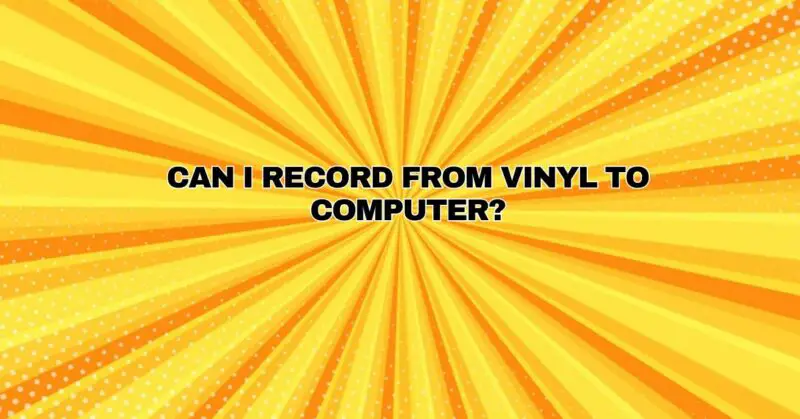Vinyl records have experienced a remarkable resurgence in recent years, drawing audiophiles and music enthusiasts back to the rich, analog sound that vinyl offers. While enjoying vinyl records on a traditional turntable is a beloved pastime, many collectors also seek the convenience of digital formats to enjoy their music on various devices. Fortunately, it’s entirely possible to record vinyl to your computer, preserving the warmth and authenticity of vinyl sound while allowing for modern playback and sharing options. In this comprehensive guide, we will explore the steps and equipment needed to successfully digitize your vinyl collection.
Why Digitize Vinyl?
Digitizing vinyl records offers several compelling advantages:
- Preservation: Vinyl records are susceptible to wear and tear over time. By creating digital copies, you can preserve your collection and minimize the risk of damage to your original records.
- Accessibility: Digital files can be easily transferred to various devices, including smartphones, tablets, and computers, allowing you to enjoy your vinyl collection wherever you go.
- Customization: Digital files can be edited and customized, enabling you to enhance audio quality, remove imperfections, and create personalized playlists.
- Sharing: Digitized vinyl tracks can be shared with friends and family, making it easy to introduce others to your favorite music.
- Backup: In the event of damage or loss of your physical records, digital copies serve as a valuable backup.
Now, let’s explore the steps and equipment needed to record vinyl to your computer.
Equipment Needed:
Before you begin the process of digitizing your vinyl records, you’ll need the following equipment:
- Turntable: You’ll need a turntable to play your vinyl records. Ensure it’s in good working condition, and the cartridge and stylus are properly aligned.
- Phono Preamp (if not built into your turntable): Some turntables have a built-in phono preamp, which is essential for vinyl playback. If your turntable lacks this feature, you’ll need an external phono preamp to connect to your computer.
- Computer: A computer with adequate storage space and a USB port is required for recording and storing digital files.
- Recording Software: You’ll need audio recording software on your computer. Options include free software like Audacity or commercial programs like Adobe Audition.
- Audio Interface (optional): An audio interface can improve sound quality and reduce noise during the recording process. While not essential, it’s a valuable addition if you’re serious about high-quality recordings.
- Stereo RCA Cables: These are necessary to connect your turntable’s output to the input of your phono preamp or audio interface.
- USB Cable: If your turntable has a USB output, you’ll need a USB cable to connect it to your computer directly.
Step-by-Step Guide to Record Vinyl to Your Computer:
Follow these steps to successfully digitize your vinyl collection:
Step 1: Set Up Your Turntable
Ensure your turntable is properly set up and calibrated. Make sure the stylus is in good condition and aligned correctly. If your turntable has a built-in phono preamp, ensure it’s active. If not, connect an external phono preamp to the turntable and your computer’s audio interface (if applicable).
Step 2: Install and Configure Recording Software
Install your chosen recording software (e.g., Audacity) on your computer. Configure the software to recognize your audio input source, which may be the phono preamp or the USB output from your turntable.
Step 3: Set Recording Parameters
Adjust recording settings such as sample rate and bit depth. For most purposes, a sample rate of 44.1 kHz and a bit depth of 16 bits (CD quality) are sufficient. Higher settings provide better audio quality but require more storage space.
Step 4: Connect Your Turntable
Connect your turntable to your computer using the appropriate cable(s). If your turntable has a USB output, connect it directly to your computer. If not, use stereo RCA cables to connect the turntable to the phono preamp, then connect the phono preamp to your computer’s audio interface (if you have one).
Step 5: Monitor and Test
Before recording, ensure that your setup is working correctly. Play a record and monitor the audio levels in your recording software. Adjust the input gain on your phono preamp or audio interface to avoid clipping (distortion caused by excessive volume).
Step 6: Begin Recording
Start your recording software and click the record button. Start playback on your turntable. Record the entire side of the vinyl, as you can edit and split tracks later.
Step 7: Monitor and Adjust
While recording, monitor the audio levels to ensure they remain within an optimal range. If you notice any issues such as excessive noise or distortion, pause the recording and investigate the source of the problem.
Step 8: Save and Edit
Once you’ve completed the recording, save the audio file in a suitable format (e.g., WAV or FLAC) to maintain high quality. If desired, you can use editing software to split tracks, remove noise, and enhance the audio quality.
Step 9: Metadata and Organization
Add metadata to your digital files, including track titles, artists, and album information. Properly organizing your digital collection makes it easier to manage and enjoy your music.
Step 10: Backup and Store
Backup your digitized vinyl collection on external hard drives or cloud storage to ensure data preservation.
Conclusion
Digitizing your vinyl records allows you to enjoy the best of both analog and digital worlds. With the right equipment and software, you can preserve your vinyl collection, share your favorite music, and enjoy the convenience of digital playback on various devices. Whether you’re a dedicated audiophile or simply looking to modernize your music collection, recording vinyl to your computer is a rewarding endeavor that enhances your music listening experience.


